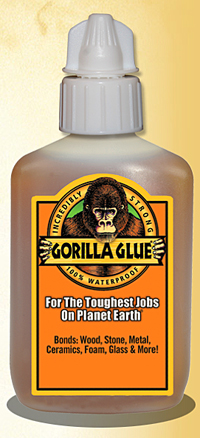
I love Gorilla Glue. Wood glue works great, but the poly stuff sets up in the bottle after only a couple of ounces have been used. Is there a trick to keeping this and other cyanoacrylate [CA] type glues usable in the bottle? Tired of throwing away one-half to three-quarters of a bottle of expensive glue because it has set up in the bottle. Glue nozzle is not contacting workpiece, so I know the glue is NOT getting contaminated with moisture, etc. What are some general suggestions for storing/saving used glue bottles? My shop is heated year-round if needed, so the inside temperature averages 50 to 80 degrees, if heat makes a difference. – Chuck Ballinger
Lauren Connley: In general, our Gorilla Glue has a one-year shelf life, so we always recommend starting out with the smaller sized bottles while people learn the right amount for their annual usage. Here are a few storage tips: for our larger sizes of glue, we suggest squeezing the air out of the bottle to eliminate as much of the moisture as possible, then tightly replacing the lid and storing in a cool, dry place. We also just introduced a new 2 oz. anti-clog cap (see photo) that will also help with reusability. To learn more about it, click here. (Lauren Connley is Gorilla Glue’s director of marketing.)
Tim Inman: Knowing the enemy is key to defeating him! Gorilla Glue is a polyurethane adhesive. It needs water vapor to react and harden. There’s your answer for shelf storage. NO WATER VAPOR AROUND THE GORILLA GLUE BOTTLE. You might want to keep your GG in a sealed glass jar with some silica gel absorbent packs between uses.
[Cyanoacrylate], on the other hand, is partly anaerobic. It sets up better in the absence of air. Excluding air from it causes it to trigger and harden. Have you ever noticed that there is a lot of air space in the bottles of CA when they’re brand-new? There’s a reason for that. If the bottles were filled to the top, you’d have hard glue on the shelf.
Personally, once I’ve opened a bottle of CA, I NEVER put the cap back on. I have absolutely no problems with the CA setting up on the shelf. I have a “neat freak” friend who insists on capping up everything, every time. He has constant problems with his CA setting up — and of course is unteachable. He’s a good friend, though…..
Chris Marshall: Call me paranoid, but I generally stick with smaller bottles of glue. It might cost me more money by not buying in volume, but I’d rather be sure that my glue is fresh when I start a new project — it’s cheap insurance. Even if I saved money by buying larger bottles, the savings would go right into the trash if the glue dried up prematurely and I had to throw it away.






